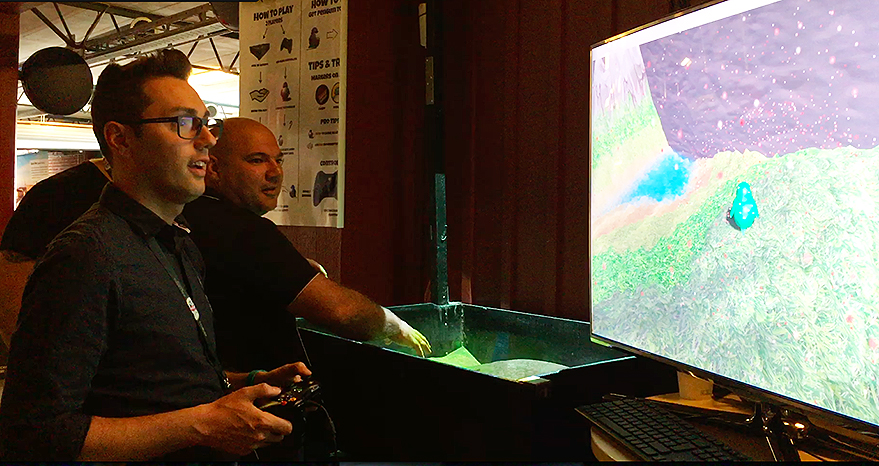Eurovision media digging students' sand game
Backstage at the Eurovision Song Contest, a sandbox has been set up near the pressroom. But this is no ordinary sandbox — it's part of a unique augmented reality game designed by five students from KTH Royal Institute of Technology.

Mad Sand takes a typical candy chasing game and a 75cm x 100cm sandbox, and puts them together to make something unique — an interactive physical/digital experience that's fun and involves teamwork.
"There are augmented reality sandboxes, where you can generate topology by moving sand around — but they don't have the game," says Huiting Wang, a student in Human Computer Interaction. "We wanted to create some potential for the interaction, to create some interaction between the physical world and the digital world."
So Wang and her classmates built a sandbox, hooked up a Microsoft Kinect motion sensor, and got busy with the coding. Before long, gamers were enjoying themselves with it a number of demo events.

The press covering Eurovision is the latest group to get addicted to Mad Sand. Wang says some of the reporters there told her they expect to become experts by the end of the week. "They're quite interested in the game — they want to stay at the top of the high score list," she says.
The project was part of a class called Advanced Computer Graphics and Interaction, which is taught by Mario Romero. The Mad Sand team (or Madsanders, as they called themselves) is comprised of Viktor Alderin, Mikael Eriksson, Lennart Jönsson, Vincent Wong, as well as Huiting Wang. "We did it very fast," Wang says. The team built and demoed the first prototype three weeks after the game was conceived in an early September brainstorming session.
"We had to present it for high school students at ForskarFredag in Stockholm at the end of September, so we had to do it very fast," Wang says. "The second iteration took one month, and we then showed it at the Comic Con Gamex at Friends Arena in late October, 2015."
The game is designed for teams of two people. One player directs an animated penguin which runs through a virtual world where the topography directly corresponds to the sandbox. The candy the penguin must catch can be high overhead, or far below the ground. This means the player in the sandbox — the "Sandmaker" — must use their hands and a shovel to alter the landscape, so the penguin can reach the candy.
"We've got lots of positive feedback about it," she says.
The game depends on Kinect technology, which scans the sand with infrared light and measures the time it takes for the light to reflect back into its camera, calculating the distance between the object and the camera. But this depth data needs to be preprocessed before it can be applied to the in-game terrain.
That preprocessing proved to be a big challenge for the students, since too much smoothing makes the game lag, while too little while make the terrain constantly flicker.
But the team worked closely and bonded personally over the challenge. And, with the preprocessing complete, their system was able to convert the depth data to a depth map that is then used by the in-game terrain.
Wang says that some potential applications for Mad Sand include map-making for games or sculpting of 3D digital objects, or even training simulations for archaeology.
"The game is just an example. If you want to create a digital map, now you need a designer or a 3D artist spending hours to create this kind of map, but if you do it in a sandbox you can then export it. Then that's one map. Change the sand, and you get another map.
"We can also make smaller versions of it, so it becomes a new way of playing for kids," she says. "It has a large potential in the market," she says.
David Callahan